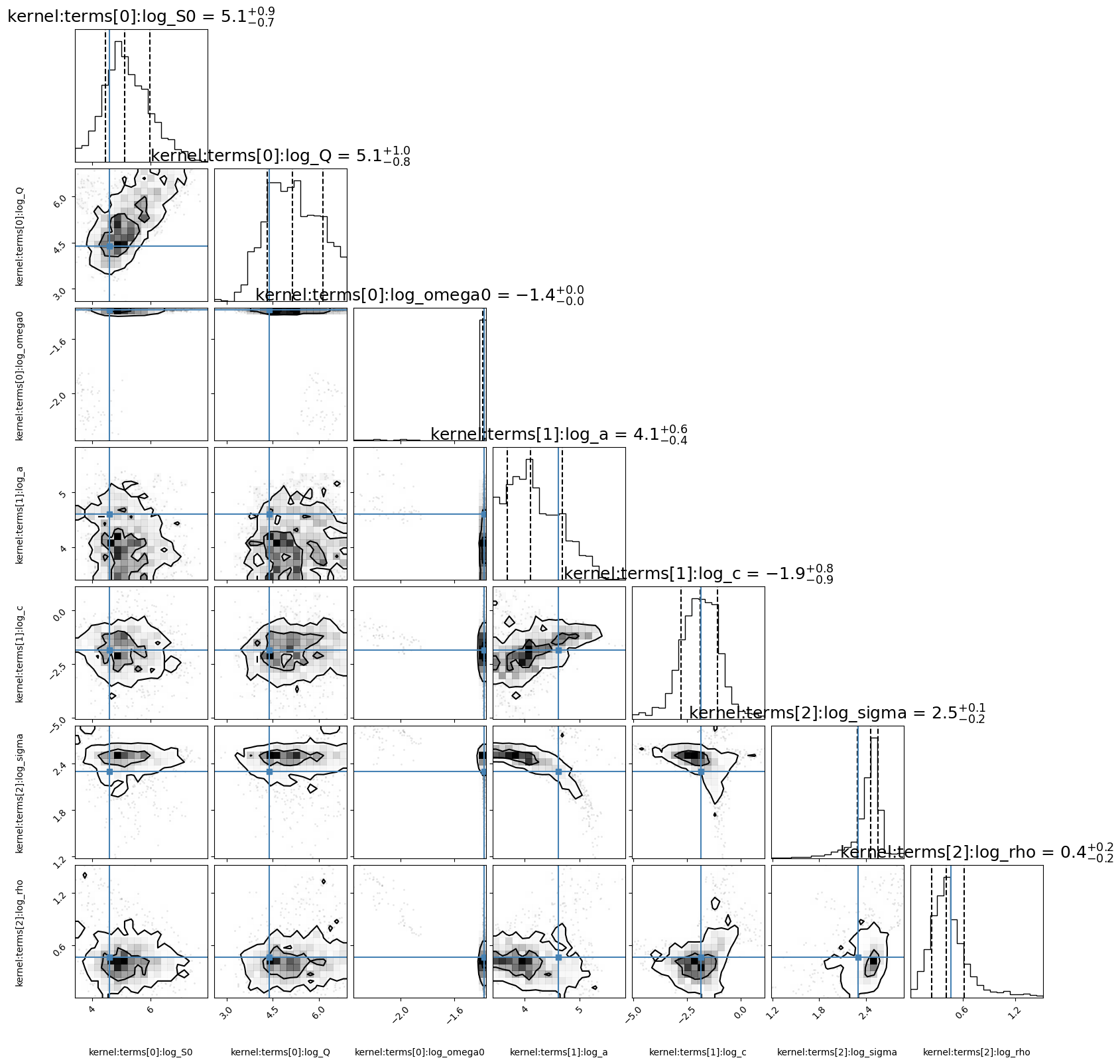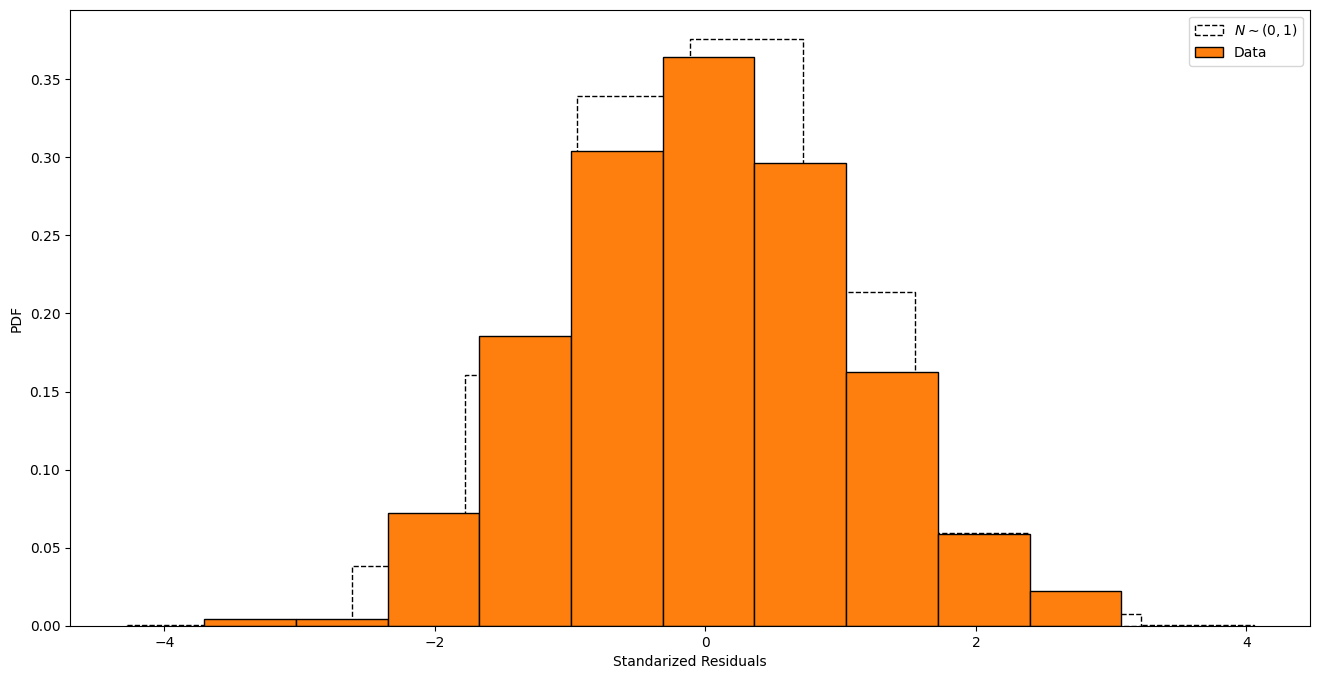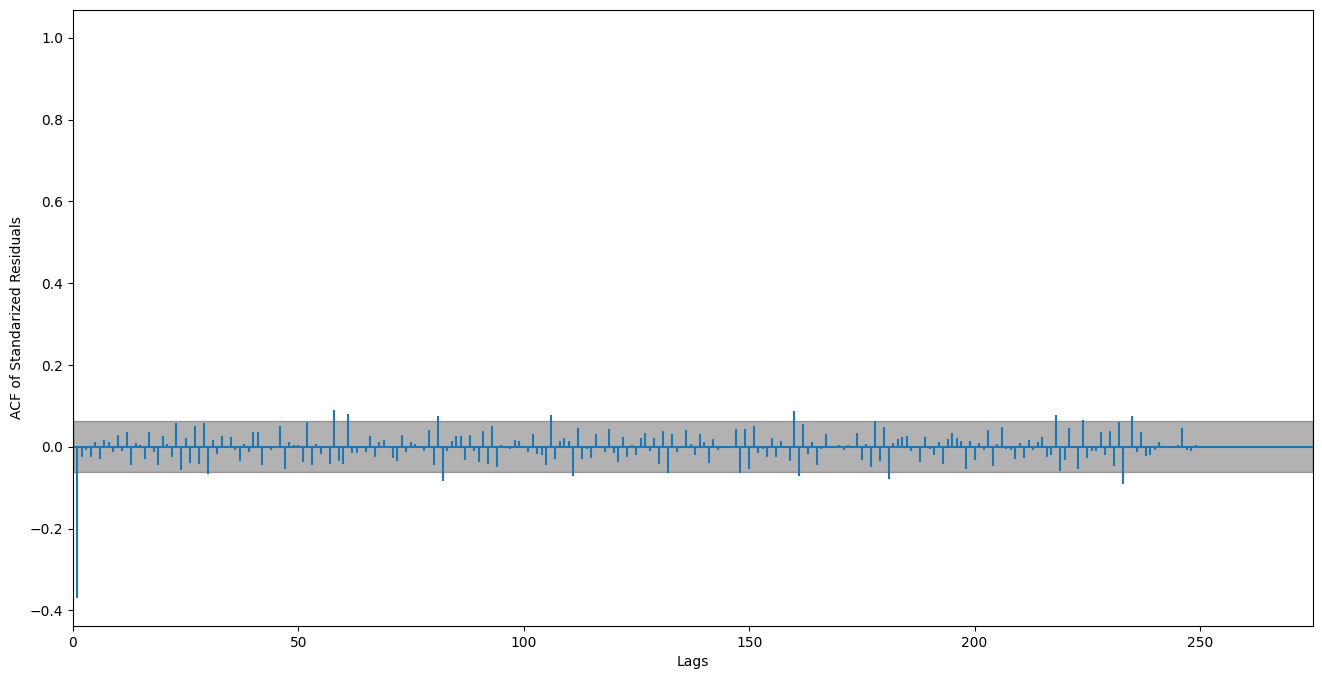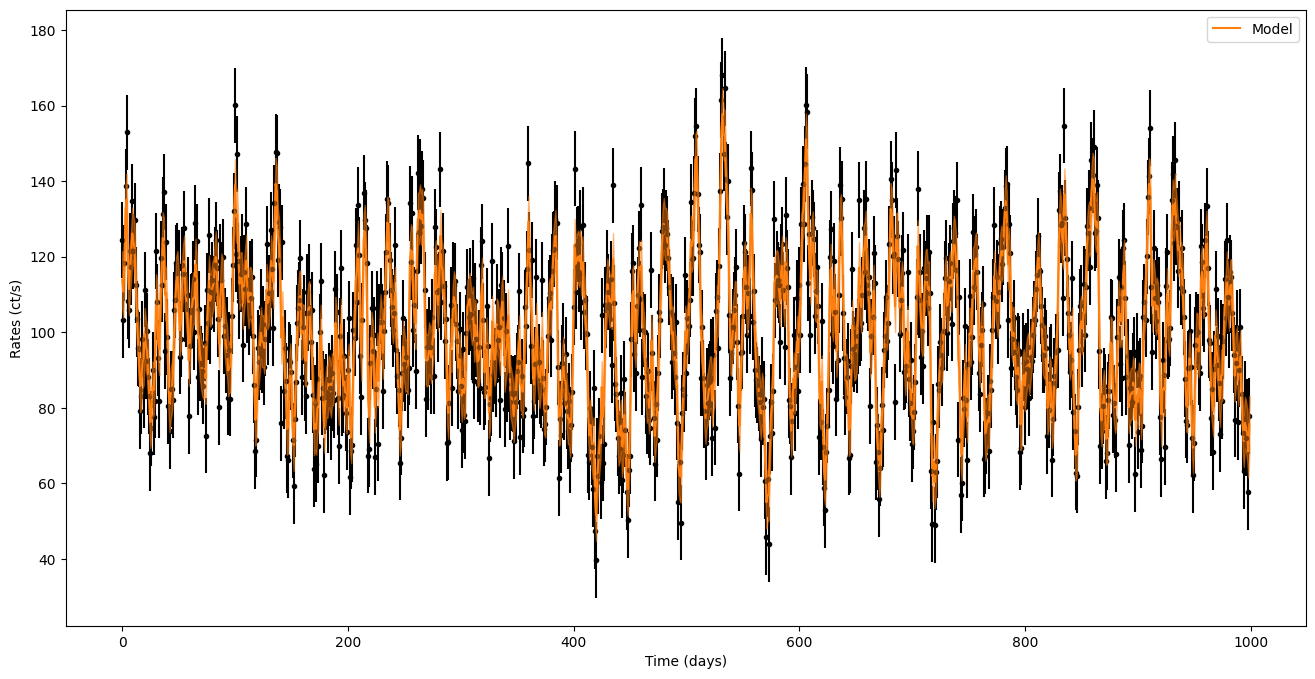[1]:
from celerite.terms import Matern32Term, RealTerm
from mind_the_gaps.models import Lorentzian
from mind_the_gaps.simulator import Simulator
from mind_the_gaps.lightcurves import GappyLightcurve
import matplotlib.pyplot as plt
from mind_the_gaps.gpmodelling import GPModelling
from mind_the_gaps.stats import aicc
from scipy.stats import norm, ks_1samp
import corner
plt.rcParams['figure.figsize'] = [16, 8]
np.random.seed(10)
Tutorial: Model Selection
Let’s first generate a lightcurve with a complex PSD, a combination of a DRW, Matern-3/2 and a QPO (Lorentzian)
[14]:
times = np.arange(0, 1000)
exposure = np.diff(times)[0]
P_qpo = 25 # period of the QPO
w = 2 * np.pi / P_qpo
mean = 100
rms = 0.1
variance_drw = (mean * rms) ** 2 # variance of the DRW (bending powerlaw)
P_drw = 40
w_bend = 2 * np.pi / P_drw # angular frequency of the DRW or Bending Powerlaw
# Define starting parameters
log_variance_qpo = np.log(variance_drw)
log_sigma_matern = np.log(np.sqrt(variance_drw))
P_matern = 10
log_rho_matern = np.log(P_matern / 2 / np.pi)
Q = 80 # coherence
log_Q = np.log(Q)
log_d = np.log(w)
print(f"log variance of the QPO: {log_variance_qpo:.2f}, log_Q: {log_Q:.2f}, log omega: {log_d:.2f}")
labels = ["Lorentzian", "DRW", "Matern-3/2"]
# You can also use Lorentzian from models.celerite_models (which is defined in terms of variance, Q and omega)
kernel = Lorentzian(log_S0=log_variance_qpo, log_Q=np.log(Q), log_omega0=log_d) \
+ RealTerm(log_a=np.log(variance_drw), log_c=np.log(w_bend)) + Matern32Term(log_sigma_matern,
log_rho_matern, eps=1e-8)
truth = kernel.get_parameter_vector()
psd_model = kernel.get_psd
# create simulator object with Gaussian noise
simulator = Simulator(psd_model, times, np.ones(len(times)) * exposure, mean, pdf="Gaussian",
sigma_noise=10, extension_factor = 2)
# simulate noiseless count rates from the PSD, make the initial lightcurve 2 times as long as the original times
countrates = simulator.generate_lightcurve()
# add (Poisson) noise
noisy_countrates, dy = simulator.add_noise(countrates)
input_lc = GappyLightcurve(times, noisy_countrates, dy, exposures=exposure)
fig = plt.figure()
plt.errorbar(times, noisy_countrates, yerr=dy, ls="None", marker=".")
plt.xlabel("Time (days)")
plt.ylabel("Rates (ct/s)")
# plot PSD
df = 1 / input_lc.duration
nyquist = 1 / (2 * exposure)
freqs = np.arange(df, nyquist, df)
fig = plt.figure()
# remember angular freqs for the PSD models
plt.plot(freqs, psd_model(2 * np.pi * freqs))
for p in [P_qpo, P_drw, P_matern]:
plt.axvline(1 / p, ls="--", color="black")
plt.xlabel("Frequency")
plt.ylabel("Power Density")
plt.xscale("log")
plt.yscale("log")
for i, term in enumerate(kernel.terms):
plt.plot(freqs, term.get_psd(2 * np.pi * freqs), label=labels[i])
plt.legend()
lc_variance = np.var(input_lc.y)
log variance of the QPO: 4.61, log_Q: 4.38, log omega: -1.38
/home/andresgur/anaconda3/lib/python3.9/site-packages/stingray/utils.py:403: UserWarning: SIMON says: Stingray only uses poisson err_dist at the moment. All analysis in the light curve will assume Poisson errors. Sorry for the inconvenience.
warnings.warn("SIMON says: {0}".format(message), **kwargs)
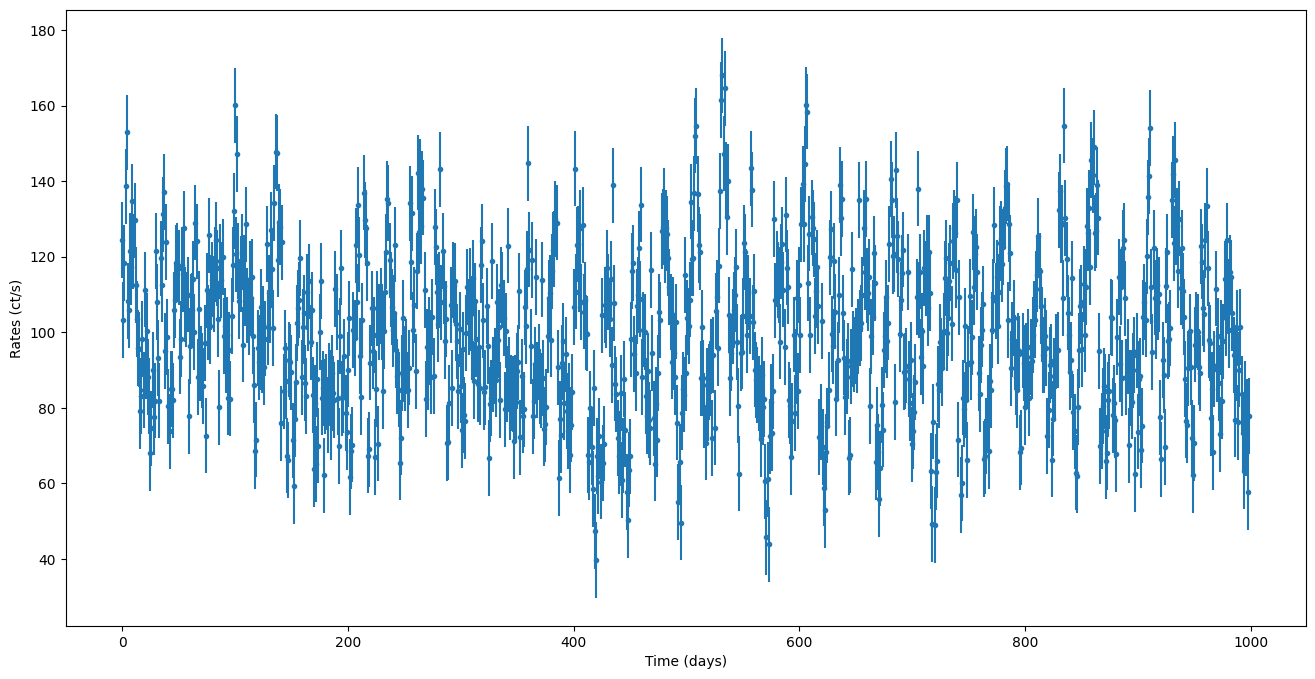
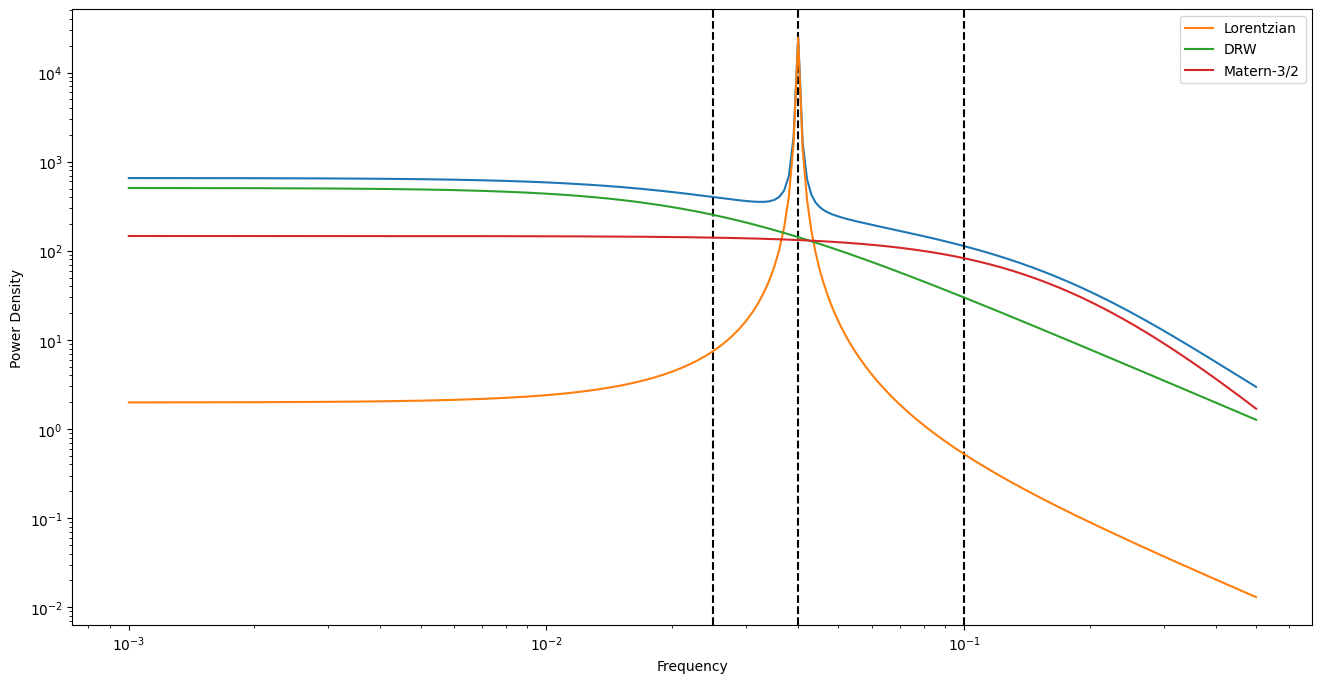
Dummy methods to construct reasonable parameter bounds
[15]:
def bounds_variance(variance, margin=15):
return np.log(variance/margin), np.log(variance * margin)
def bounds_bend(duration, dt):
nyquist = 1 / (2 * dt)
return np.log(2 * np.pi/duration), np.log(nyquist * 2 * np.pi)
Define models to be tested and their bounds based on the data
[16]:
variance_bounds = bounds_variance(lc_variance)
print(variance_bounds)
bend_bounds = bounds_bend(input_lc.duration, exposure)
print(bend_bounds)
sigma_bounds = bounds_variance(np.sqrt(lc_variance))
timescale_bounds = ((np.log(exposure), np.log(input_lc.duration)))
print(timescale_bounds)
# limit Q lower bound to "periodic" components
Q_bounds = (np.log(1.5), np.log(1000))
log_var = np.log(lc_variance)
realterm = RealTerm(log_var, np.log(2 * np.pi / 50), bounds=[variance_bounds, bend_bounds])
lorentzian = Lorentzian(log_var, np.log(100), np.log(2 * np.pi/10),
bounds=[variance_bounds, Q_bounds, bend_bounds])
matern = Matern32Term(np.log(np.sqrt(lc_variance)), np.log(10), bounds=[sigma_bounds, timescale_bounds],
eps=1e-8)
models = [realterm,
matern,
lorentzian + realterm,
lorentzian + realterm + matern
,]
(3.417056836156067, 8.833157238360487)
(-5.068877712239208, 1.1447298858494002)
(0.0, 6.906754778648553)
Derive AICc and p-values for the standarized residuals following a normal (0, 1) distribution
[17]:
cpus = 12
aiccs = []
pvalues = []
gps = []
for kernel in models:
print(kernel)
print("------------------------------------------------------------------")
gp = GPModelling(input_lc, kernel)
# here we first minimize the likelihood and then run a small MCMC to ensure we find the maximum of the loglikelihood
gp.derive_posteriors(fit=True, max_steps=2000, walkers=2 * cpus, cores=cpus, progress=False)
best_pars = gp.max_parameters
gp.gp.set_parameter_vector(best_pars)
std_res = gp.standarized_residuals()
pvalue = ks_1samp(std_res, norm.cdf).pvalue
AICc = aicc(gp.max_loglikelihood, gp.k, input_lc.n)
print(f"p-value:{pvalue:.3f} | AICC: {AICc:.2f}")
pvalues.append(pvalue)
aiccs.append(AICc)
gps.append(gp)
RealTerm(6.125107037258277, -2.0741459390188006)
------------------------------------------------------------------
p-value:0.354 | AICC: 8397.97
Matern32Term(3.0625535186291386, 2.3025850929940455, eps=1e-08)
------------------------------------------------------------------
/home/andresgur/anaconda3/lib/python3.9/site-packages/mind_the_gaps/gpmodelling.py:209: UserWarning: The chains did not converge after 2000 iterations!
warnings.warn(f"The chains did not converge after {sampler.iteration} iterations!")
p-value:0.000 | AICC: 8397.02
(Lorentzian(6.125107037258277, 4.605170185988091, -0.46470802658470023) + RealTerm(5.890515403113098, -1.490484347331502))
------------------------------------------------------------------
p-value:0.866 | AICC: 8283.26
(Lorentzian(4.792317694191546, 4.88245622156523, -1.381704165724039) + RealTerm(5.3258366603280365, -0.9582493463338226) + Matern32Term(2.9179435023277605, 0.9755365010911353, eps=1e-08))
------------------------------------------------------------------
p-value:0.234 | AICC: 8271.67
Finally our best-fit model is that which minimizes the AICc
[18]:
best_gp = gps[np.argmin(aiccs)]
print(best_gp.max_parameters)
print(f"Best model {models[np.argmin(aiccs)]} has a p-value: {pvalues[np.argmin(AICc)]:.3f}")
corner_fig = corner.corner(best_gp.mcmc_samples, labels=best_gp.gp.get_parameter_names(),
title_fmt='.1f', truths=truth,
quantiles=[0.16, 0.5, 0.84], show_titles=True,
title_kwargs={"fontsize": 18}, max_n_ticks=3, labelpad=0.08,
levels=(1 - np.exp(-0.5), 1 - np.exp(-0.5 * 2 ** 2))) # plots 1 and 2 sigma levels
plt.savefig("corner.png")
#
best_gp.gp.set_parameter_vector(gp.max_parameters)
print(best_gp.gp.get_parameter_vector())
pred_mean, pred_var = gp.gp.predict(input_lc.y, return_var=True)
# standarized residuals
plt.figure()
std_res = gp.standarized_residuals()
plt.hist(norm.rvs(size=10000), edgecolor="black" , ls="--",
facecolor="None", density=True, label="$N\sim(0, 1)$")
plt.hist(std_res, density="True", edgecolor="black", label="Data")
plt.xlabel("Standarized Residuals")
plt.ylabel("PDF")
plt.legend()
plt.savefig("std_res.png")
# ACF
plt.figure()
plt.acorr(std_res, maxlags=len(std_res) // 4 )
plt.xlim(0)
# 2 sigma
plt.axhspan(-1.96 / np.sqrt(len(std_res)), 1.96 / np.sqrt(len(std_res)), alpha=0.3, color="black")
plt.ylabel("ACF of Standarized Residuals")
plt.xlabel("Lags")
plt.savefig("acf.png")
# best-fit model
fig = plt.figure()
plt.errorbar(times, noisy_countrates, yerr=dy, ls="None", marker=".", color="black")
plt.xlabel("Time (days)")
plt.ylabel("Rates (ct/s)")
plt.plot(times, pred_mean, label="Model", color="C1")
plt.fill_between(times, pred_mean - np.sqrt(pred_var), pred_mean + np.sqrt(pred_var),
zorder=10, color="C1", alpha=0.5)
plt.legend()
plt.savefig("model.png")
[ 5.15908666 5.25242233 -1.38295107 3.70316209 -2.45743742 2.53347983
0.41828181]
Best model (Lorentzian(5.159086655562463, 5.252422330743234, -1.3829510731975914) + RealTerm(3.7031620896713306, -2.4574374227927263) + Matern32Term(2.53347983259417, 0.4182818080018121, eps=1e-08)) has a p-value: 0.354
[ 5.15908666 5.25242233 -1.38295107 3.70316209 -2.45743742 2.53347983
0.41828181]
